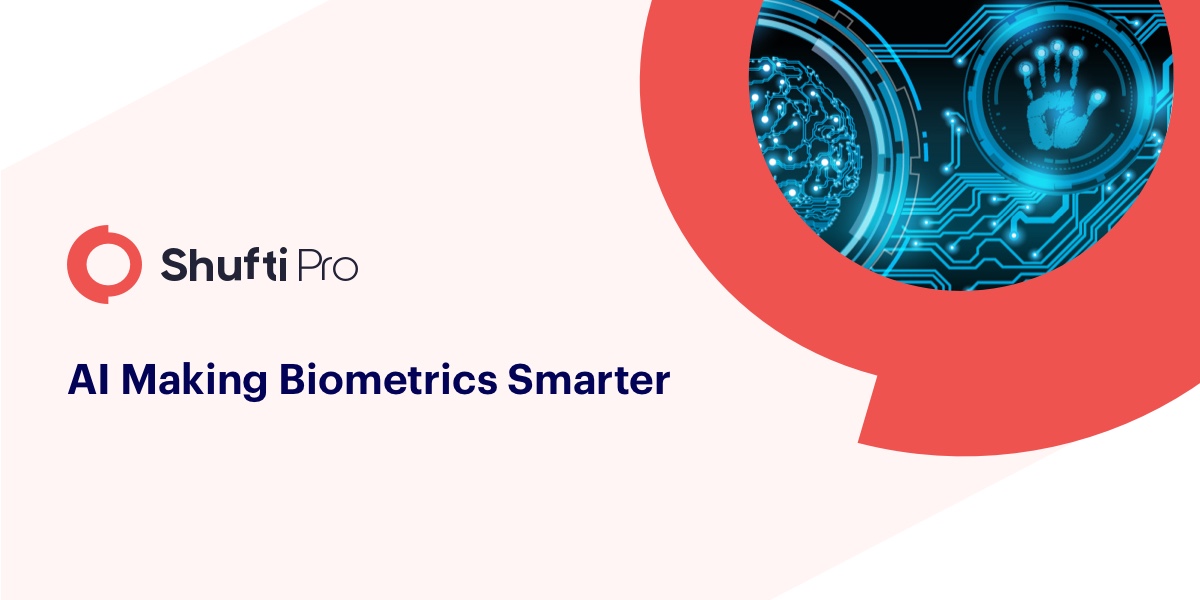Biometric Authentication is Smart but AI Makes it Smarter – Here is How

In the ongoing digital age security is a top priority concern of any organization. Data is a major resource for every organization so advanced security measures have to be taken to safeguard business data. Major data breach cases have hit some highly renowned companies leaving us with eyes wide open. Yahoo, Google, Facebook, etc have fallen prey to data breaches exposing vital data from millions of customers. Therefore, businesses are constantly looking for better alternatives to traditional security models.
Biometric authentication such as fingerprint, facial, iris scans is being utilized for authenticating employees at the workplace and identifying customers to fulfill KYC and KYB regulations. Biometrics has given a death blow to the good old method of authentication like passwords, PIN, and codes making us hassle-free of changing or remembering these codes. Biometrics is a multifactor authentication which with the help of AI can help develop data-driven security protocols. AI transforms biometric authentication to give birth to a dynamic security system for a business.
Biometric Identification- A Growing Trend
Biometric identification solutions have been in the spotlight in recent years. Following are the major factors behind this growing popularity:
- Many countries around the world have already started making efforts to establish a biometric identification of their citizens.
- Many organizations leveraging biometric identification for applications like employee attendance, door security, and logical access.
- Manufacturers using a biometric ability (e.g. fingerprint face and iris recognition) on mobile and computing devices.
What is AI Biometrics?
Biometric technology use unique traits of particular part of the body comprising facial recognition, iris scan, fingerprint scan, etc.AI transform these informative distinctive traits into codes or make them more complex and easy to understand by the system. Person’s typing rhythm, walking pattern, voice, etc can be recognized to verify a person using AI biometrics.
Types of Biometric ID Validation:
Before going into the details of how AI can enhance biometrics let’s have a look at its types. The biometric technology comprises many different types, including but not limited to these:
Fingertip recognition:
Analyzing fingertip structures to identify users identity.
Iris recognition:
Detection of specific features in the iris of the eye
Face recognition:
The technology is based on features like nose width, chin, and jawline, using face recognition algorithms that map the face.
Voice recognition:
Used for speaker’s voice authentication
Palm recognition:
Detects vein patterns or hand geometry of the user
DNA matching:
DNA matching uses a physical sample of an individual such as blood, hair, or saliva to confirm their identity. DNA matching is widely used in forensic investigations due to its unparalleled accuracy.
Ear acoustic authentication:
The size and shape of every human ear are unique. The size and shape of human ears help in collecting sound waves and routing them with the help of the ear canal. Special earphones with a microphone can capture soundwaves reflected inside the ear canal. The reflected sound waves captured by the microphone are used for the identification of an individual.
How Can AI Transform Biometric Authentication System?
Artificial intelligence AI has become a fundamental aspect of our lives and demonstrates intelligence by machines. When employed with bio authentication data it can provide a genuine authentication solution making it difficult to be fooled by cybercriminals. AI and biometric ID validation can work together in the following ways:
-
AI-Powered Keystroke Dynamics
As the writing of everyone differs, typing pattern varies from person to person so it can help to identify and authenticate individual on the basis of typing pattern. With AI keystroke dynamics can identify people with the help of dwell time, speed, and fight time. Dwell time refers to the duration of a key being pressed whereas fight time is the interval between releasing key and pressing another key. This feature can also be used to enhance the multi-factor authentication system along with PIN numbers or passwords. AI systems can track information about the most frequently used keys to identify individuals.
-
AI-Powered Facial Recognition
Facial recognition is thought to be easily tricked with the help of a video or a picture of the owner. There are cases in which facial recognition systems can be fooled by the face of an owner’s sibling. Such incidents occur due to inaccuracies in 2D facial recognition. Law enforcement agencies are looking for better enhancements in biometric authentication as it fails at times due to the fact that criminal’s faces may not be fully visible in public places.
This is where AI comes into play. AI uses 3D biometrics for successful face detection of a person and learns from millions of images. AI can analyze the picture of old [reasons to create younger images. So this validates the fact that with AI and biometrics together more authentic model for face recognition can be created.
-
AI-Powered Voice Recognition:
Voice and speech recognition can be used for multiple tasks like answering queries, ordering products or playing music by certain smart home devices such as Google Home and Amazon Alexa. But this method fails in noisy backgrounds or can not recognize the voice of the user. Whereas AI can train such biometric systems using millions of voice samples of different users. Voice patterns can be analyzed such as speed, accent, tone, and pitch. So AI can evaluate a person’s biometric voice signature which is unique. This makes this process fast and accurate. AI-based speech recognition can be used in the workplace for authentication and attendance purposes.
-
AI-Powered Gait Detection:
The University of Manchester, AI promises an accuracy of 99.3% when used in gait detection. Gait detection as the name suggests is the walking pattern of individuals that can be detected using AI as it differs somehow. Gait detection can be a viable solution with the help of AI. Soil sensors can be used to detect the walking pattern of an individual. With the help of AI, it is possible to detect the movement of the march for the security of the airport and in healthcare to detect certain diseases.
How is AI Smarter?
Although biometrics are trusted for accurate authentication advanced technology like AI can be used to deceive this system. Fingerprint scanning can be fooled easily by AI-generated synthetic fingerprints a study suggests. The biometric system analyzes partial fingerprints to find matches with saved multiple fingerprints, as a user can scan multiple fingerprints in the device. The major flaw in the biometric system is the inaccurate generation of such fingerprints. With a hat of fingerprints, counterfeits created by AI can be more unique and accurate. Such fingerprints are used for testing every generated fingerprint until the target device is unlocked. This put several devices at risk of force attack resulting in identity theft and other digital scams. Likewise, AI and biometrics can be clubbed to create a secure biometric system. This combination can help to develop a secure system that can be used to mitigate risks and frauds.
Conclusion
Needless to say, biometric authentication is fostering a change in many business sectors and is being adopted widely over old methods of authentication. It is becoming critical to the development of many industries. Biometric technology along with AI is paving ways in identity verification procedures and mitigating security risks. People may still have some doubts regarding data privacy protection, biometrics already makes an impact on various fields of life and work.
AI and biometrics can precisely verify the identity of individuals based on their physiological and behavioral traits. Hence, business like financial institutes, education sector, healthcare can introduce AI-based biometrics for their workplaces and customers to offer user-friendly and secure authentication protocols. AI-powered biometrics may become mainstream soon as they provide more promising solutions. Biometric verification technology plays a vital role in providing security in different sectors so this technology must be secure enough.










